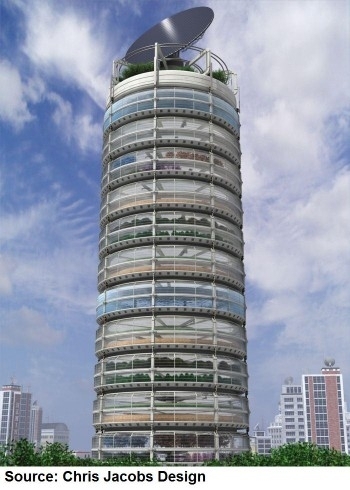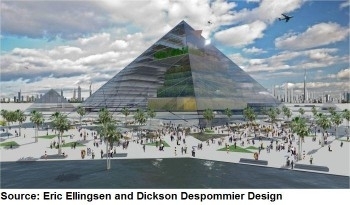Farmland is being lost at an alarming rate across the entire world due to urbanization, desertification, and erosion. More than one acre of U.S. farmland was lost per minute from 2002 to 2007, due largely in part to development, according to the American Farmland Trust. The world’s population is set to hit 9.2 billion by 2050, according to the U.N., and crop production yields are not going to be able to increase fast enough to meet global demand.
In order to feed the world’s growing population and food needs, the traditional concept of farming may take a new direction. What if instead of expanding crop production on a horizontal level, as in expanding land, crop production is expanded in the other dimension, vertically?
The concept of vertical farming, which takes land expansion to the next dimension, was created by Prof. Dickenson Despommier of Columbia University. Vertical farms are large structures, like office buildings, where each level is filled with crop production. It can be thought of taking a greenhouse and stacking 25 of them on top of each other.
Vertical Farming
The concept behind vertical farming is to produce crops in an urban environment to feed city residents. Producing the crops near the end user is much more efficient and cuts down and transportation costs and pollution. The distance it takes for fruits and vegetables to travel to Chicago from where they are grown can be upwards of 2,000 miles.
All of the crops grown in vertical farms are planned to be grown hydroponically. Hydroponic means that plant roots sit in a material, like wall insulation, instead of soil. The roots are then exposed to a constant stream of nutrient rich water that is absorbed by plant roots. Researchers have discovered that plants can absorb mineral nutrients through water and soil is not essential to plant growth.
Hydroponics and vertical farming creates farmland without the need for soil while having the potential to produce 20 times the yield amount of outdoor practices using 1/10 the amount of water, according to Prof. Despommier. Vertical farms are capable of growing food year-round. As soon as a plant matures, another takes its place. There is no down time and since no soil is being used, crops can continually grow.
Vertical farms will also be used for water treatment, by taking in black city water and converting it to the water used in the hydroponic planting methods. The collected solid portion of the black water can be used as biofuel and burned to help generate electricity. In addition to using converted black water, vertical farms will collect water of evapotranspiration to create potable water.
Design
No large scale vertical farms have been built yet, but architects have been busy creating concepts. Many of the concept buildings make use of wind turbines on their roofs alongside solar panels to help offset electricity needs.
Light will ultimately become a limiting factor for crop yields as light is not available to the entire vertical farm at the same time. Plants nearest to parameter windows will receive more sunlight than interior plants. A simple solution would be to add grow lights throughout the facility, but the costs associated with grow lights are too high. Many of the designs for vertical farms try to solve the issue of low light through creative design.
Cost will always be the underlining issue on new advances in farming, but when food supply levels get to the point where vertical farming is cost effective, there will be a race for new technologies. Building costs are difficult to estimate as there are not any comparable projects yet. Prof. Despommier estimates it would costs roughly $83 million for the total building costs. Below is the breakdown:
• Sub-structure and electro-chromic glass shell - $25,000,000
• 1000 ton Geothermal HVAC - $2,500,000
• 400 ton chiller + cooling tower - $500,000
• Biogas to fuel cell cogeneration facility - $11,000,000
• 800 kWh/day tracking photovoltaic array - $500,000
• 4,500 kW water-cooled lighting system - $2,000,000
• Energy infrastructure and automation systems - $35,000,000
• Living machine-based water recycling system - $500,000
• Floating garden hydroponic system - $1,700,000
• Office and laboratory facilities - $5,000,000
• Total Building Cost for vertical farming is around $83.7 million
Including maintenance and operations, total costs would reach $100 million. This sounds like a large number, but if commodity prices rise high enough, vertical farming may be costs effective due to its efficiency in yields and reduction in transportation costs.
The construction and maintenance of vertical farms will require a lot of human work in order to carry out all planting, harvesting, and maintenance involved with the farm. Job creation will be a large benefit of vertical farming.
Future
The growing demand and high grain prices will demand new technologies, including vertical farming, but we don’t quite know when that day will come. Traditional farms cannot keep up with growing food demand and the concept of vertical farming is a great alternative method to grow fruits and vegetables.
Visit http://farmlandforecast.colvin-co.com for daily articles on farmland and agriculture.
Disclosure: I have no positions in any stocks mentioned, and no plans to initiate any positions within the next 72 hours.